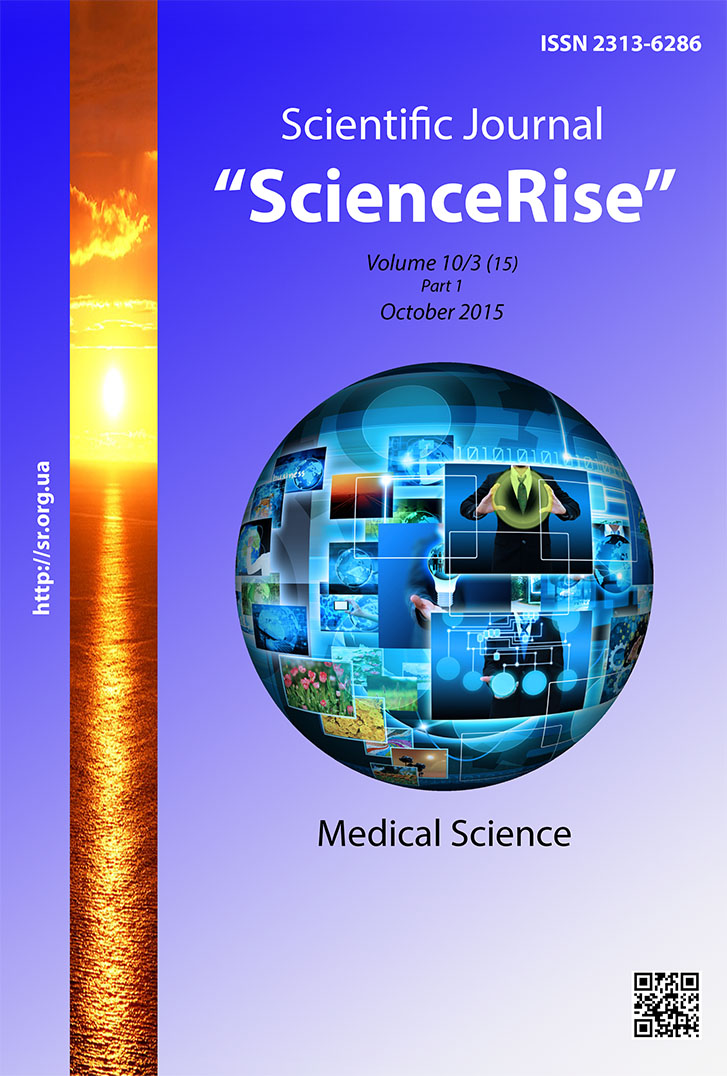Імунозапалення, ендотеліальна дисфункція як фактори високого кардіометаболічного ризику у хворих на гіпертонічну хворобу з дисглікемією
DOI:
https://doi.org/10.15587/2313-8416.2015.51655Ключевые слова:
імунозапалення, гіпертонічна хвороба, цукровий діабет 2 тип, інтелейкін-6, онкостатин М, ендотеліальна дисфункціяАннотация
У статті досліджено активність цитокінів у взаємозв’язку з параметрами вазоактивного пулу оксиду азоту у хворих на гіпертонічну хворобу з дисглікемією. Використовувались клінічні, біохімічні, імуноферментні, статистичні методи дослідження. Встановлено, що гіперглікемія, інсулінорезистентність є тригерами системного імунозапалення та ендотеліальної дисфункції у хворих на гіпертонічну хворобу
Библиографические ссылки
Kovalyova, O. M., Ambrosova, T. M., Ashcheulova, T. V. et. al (2014). Biomarkery kardiovasculyarnogo rysyky pry arterialnyi hipertensyii [Biomarkers of cardiovascular risk in arterial hypertension]. Kharkiv: Planet-print, 165.
Kovalyova, O. M., Ashcheulova, T. V., Demydenko, G. V., Sytina, I. V. (2011). Sertsevo-sudynnyi rysyk: stratiphikatzia, pathogenez, prognoz [Cardiovascular risk: stratification, pathogenesis, prognosis]. Kharkiv: Raritety Ukrainy, 224.
Selvin, E., Steffes, M. W., Zhu, H., Matsushita, K., Wagenknecht, L., Pankow, J. et. al (2010). Glycated hemoglobin, diabetes, and cardiovascular risk in nondiabetic adults. New England Journal of Medicine, 362 (9), 800–811. doi: 10.1056/nejmoa0908359
Tousoulis, D., Kampoli, A.-M., Stefanadis, C. (2012). Diabetes mellitus and vascular endothelial dysfunction: current perspectives. Current Vascular Pharmacology, 10 (1), 19–32. doi: 10.2174/157016112798829797
Tousoulis, D., Papageorgiou, N., Androulakis, E., Siasos, G., Latsios, G., Tentolouris, K., Stefanadis, C. (2013). Diabetes Mellitus-Associated Vascular Impairmen. Journal of the American College of Cardiology, 62 (8), 667–676. doi: 10.1016/j.jacc.2013.03.089
Kubin, T., Pöling, J., Kostin, S., Gajawada, P., Hein, S., Rees, W. et. al (2011). Oncostatin M is a major mediator of cardiomyocyte dedifferentiation and remodeling. Cell Stem Cell, 9 (5), 420–432. doi: 10.1016/j.stem.2011.08.013
Mancia, G., Laurent, S., Agabiti-Rosei, E., Ambrosioni, E., Burnier, M., Caulfield, M. J. et. al (2009). Reappraisal of European guidelines on hypertension management: a European Society of Hypertension Task Force document. Journal of Hypertension, 27 (11), 2121–2158. doi: 10.1097/hjh.0b013e328333146d
Definition and Diagnosis of Diabetes Mellitus and Intermediate Hyperglicemia: Report of WHO/IDF Consultation (2006). Geneva, World Health Organization, 46. Available at: https://www.idf.org/webdata/docs/WHO_IDF_definition_diagnosis_of_diabetes.pdf
Kovalyova, O. M., Demydenko, G. V., Horbach, T. V. (2007). Diagnostika endotelialnoyi funktsii – otsinka vasoaktivnogo pyly oksidy asoty. [Diagnostics of endothelial function]. Kyiv, 19.
Prattichizzo, F., Giuliani, A., Ceka, A., Rippo, M. R., Bonfigli, A. R., Testa, R. et. al (2015). Epigenetic mechanisms of endothelial dysfunction in type 2 diabetes. Clinical Epigenetics, 7 (1). doi: 10.1186/s13148-015-0090-4
Tabit, C. E., Chung, W. B., Hamburg, N. M., Vita, J. A. (2010). Endothelial dysfunction in diabetes mellitus: Molecular mechanisms and clinical implications. Reviews in Endocrine and Metabolic Disorders, 11 (1), 61–74. doi: 10.1007/s11154-010-9134-4
Ketete, M., Cherqaoui, R., Maqbool, A. R., Kwagyan, J., Xu, S., Randall, O. S. (2013). Endothelial dysfunction: The contribution of diabetes mellitus to the risk factor burden in a high risk population. Journal of Biomedical Science and Engineering, 06 (06), 593–597. doi: 10.4236/jbise.2013.66075
Würtz, P., Tiainen, M., Makinen, V.-P., Kangas, A. J., Soininen, P., Saltevo, J. et. al (2012). Circulating Metabolite Predictors of Glycemia in Middle-Aged Men and Women. Diabetes Care, 35 (8), 1749–1756. doi: 10.2337/dc11-1838
Nieto-Vazquez, I., Fernandez-Veledo, S., de Alvaro, C., Lorenzo, M. (2008). Dual role of interleukin-6 in regulating insulin sensivity in murine skeletal muscle. Diabetes, 57 (12), 3211–3221. doi: 10.2337/db07-1062
Fève, B., Bastard, J.-P. (2009). The role of interleukins in insulin resistance and type 2 diabetes mellitus. Nature Reviews Endocrinology, 5 (6), 305–311. doi: 10.1038/nrendo.2009.62
Загрузки
Опубликован
Выпуск
Раздел
Лицензия
Copyright (c) 2015 Ганна Валеріївна Демиденко

Это произведение доступно по лицензии Creative Commons «Attribution» («Атрибуция») 4.0 Всемирная.
Наше издание использует положения об авторских правах Creative Commons CC BY для журналов открытого доступа.
Авторы, которые публикуются в этом журнале, соглашаются со следующими условиями:
1. Авторы оставляют за собой право на авторство своей работы и передают журналу право первой публикации этой работы на условиях лицензии Creative Commons CC BY, которая позволяет другим лицам свободно распространять опубликованную работу с обязательной ссылкой на авторов оригинальной работы и первую публикацию работы в этом журнале.
2. Авторы имеют право заключать самостоятельные дополнительные соглашения, которые касаются неэксклюзивного распространения работы в том виде, в котором она была опубликована этим журналом (например, размещать работу в электронном хранилище учреждения или публиковать в составе монографии), при условии сохранения ссылки на первую публикацию работы в этом журнале .

